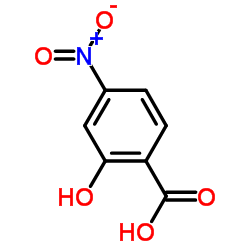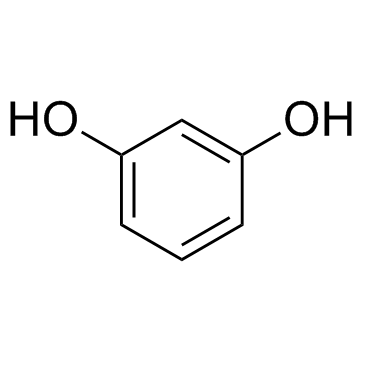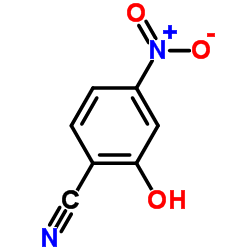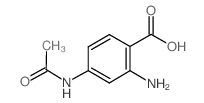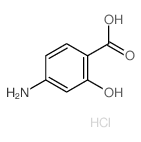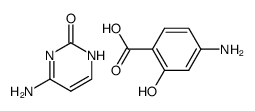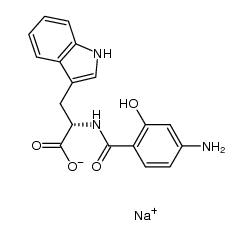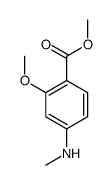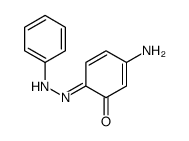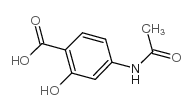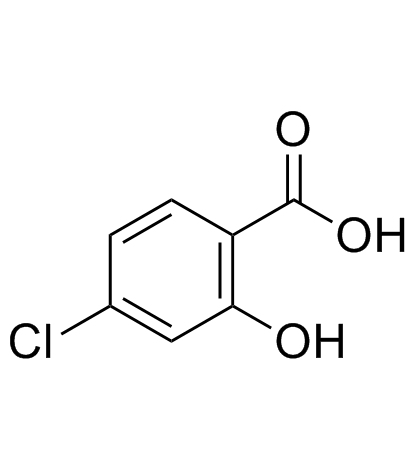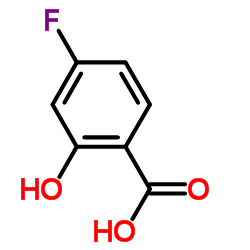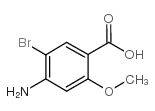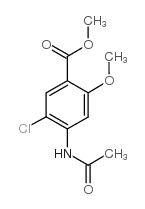65-49-6
| 中文名 | 4-氨基水杨酸 |
|---|---|
| 英文名 | 4-aminosalicylic acid |
| 中文别名 |
4-氨基-2-羟基苯甲酸
对氨基水杨酸 4-氨基柳酸 |
| 英文别名 |
PAS
4-Asa Bactylan Pasalon-rakeet Aminox Tubersan para-amino salicylic acid Salvis Paracipan 4-Amino-2-hydroxybenzoic acid Sanipirol Lepasen PASA Apas Pasmicina p-aminosalicylic acid Rezipas 4-amino-salicylic acid EINECS 200-613-5 ZR CQ DVQ Passodico PASK 4-Aminosalicylic acid MFCD00007789 A 1909 Aminosalicylic Acid Aminacyl Paser PAS-C Pasem Mesalazine Impurity 5 |
| 描述 | 4-Aminosalicylic acid 是具有口服活性的抗生素,可用于肺结核病的研究。 |
|---|---|
| 相关类别 | |
| 参考文献 |
| 密度 | 1.5±0.1 g/cm3 |
|---|---|
| 沸点 | 380.8±32.0 °C at 760 mmHg |
| 熔点 | 135-145 °C(lit.) |
| 分子式 | C7H7NO3 |
| 分子量 | 153.135 |
| 闪点 | 184.1±25.1 °C |
| 精确质量 | 153.042587 |
| PSA | 83.55000 |
| LogP | 1.14 |
| 外观性状 | 微小的晶体,无气味的,或有淡醋的气味 |
| 蒸汽压 | 0.0±0.9 mmHg at 25°C |
| 折射率 | 1.691 |
| 储存条件 | 本品应密封避光保存。 |
| 水溶解性 | 2 g/L (20 ºC) |
| 分子结构 | 1、 摩尔折射率:39.30 2、 摩尔体积(cm3/mol):102.6 3、 等张比容(90.2K):310.2 4、 表面张力(dyne/cm):83.3 5、 极化率(10-24cm3):15.57 |
| 计算化学 | 1、 疏水参数计算参考值(XlogP):1.3 2、 氢键供体数量:3 3、 氢键受体数量:4 4、 可旋转化学键数量:1 5、 互变异构体数量:12 6、 拓扑分子极性表面积(TPSA):83.6 7、 重原子数量:11 8、 表面电荷:0 9、 复杂度:160 10、 同位素原子数量:0 11、 确定原子立构中心数量:0 12、 不确定原子立构中心数量:0 13、 确定化学键立构中心数量:0 14、 不确定化学键立构中心数量:0 15、 共价键单元数量:1 |
| 更多 | 1. 性状:白色结晶性粉末。无气味或微有酸的气味。对光敏感。露于空气中易变为棕色。 2. 密度(g/mL,25/4℃): 1.371 3. 相对蒸汽密度(g/mL,空气=1):未确定 4. 熔点(ºC):150~151(分解并起泡) 5. 沸点(ºC,常压):未确定 6. 沸点(ºC,5.2kPa):未确定 7. 折射率:1.652 8. 闪点(ºC):未确定 9. 比旋光度(º):未确定 10. 自燃点或引燃温度(ºC):未确定 11. 蒸气压(kPa,25ºC):未确定 12. 饱和蒸气压(kPa,60ºC):未确定 13. 燃烧热(KJ/mol):未确定 14. 临界温度(ºC):未确定 15. 临界压力(KPa):未确定 16. 油水(辛醇/水)分配系数的对数值:未确定 17. 爆炸上限(%,V/V):未确定 18. 爆炸下限(%,V/V):未确定 19. 溶解性:40℃以上时水溶液不稳定,分解并放出二氧化碳而成为间氨基酚。1g产品溶于21ml乙醇、约500ml水。溶于稀硝酸、稀氢氧化钠溶液,微溶于乙醚,几乎不溶于苯。 |
Synonym:PAS; 4-Amino-2-hydroxybenzoic aci Section 2 - COMPOSITION, INFORMATION ON INGREDIENTS
Risk Phrases: None Listed. Section 3 - HAZARDS IDENTIFICATION EMERGENCY OVERVIEW
Light sensitive.Air sensitive. Potential Health Effects Eye: Causes eye irritation. Skin: May cause skin irritation. Ingestion: May cause irritation of the digestive tract. Inhalation: May cause respiratory tract irritation. Chronic: No information found. Section 4 - FIRST AID MEASURES Eyes: Flush eyes with plenty of water for at least 15 minutes, occasionally lifting the upper and lower eyelids. Get medical aid. Skin: Get medical aid. Flush skin with plenty of water for at least 15 minutes while removing contaminated clothing and shoes. Get medical aid if irritation develops or persists. Wash clothing before reuse. Ingestion: If victim is conscious and alert, give 2-4 cupfuls of milk or water. Never give anything by mouth to an unconscious person. Get medical aid. Do NOT induce vomiting. If conscious and alert, rinse mouth and drink 2-4 cupfuls of milk or water. Inhalation: Remove from exposure and move to fresh air immediately. If not breathing, give artificial respiration. If breathing is difficult, give oxygen. Get medical aid if cough or other symptoms appear. Get medical aid. Notes to Physician: Antidote: None reported. Section 5 - FIRE FIGHTING MEASURES General Information: As in any fire, wear a self-contained breathing apparatus in pressure-demand, MSHA/NIOSH (approved or equivalent), and full protective gear. During a fire, irritating and highly toxic gases may be generated by thermal decomposition or combustion. Extinguishing Media: Use agent most appropriate to extinguish fire. Section 6 - ACCIDENTAL RELEASE MEASURES General Information: Use proper personal protective equipment as indicated in Section 8. Spills/Leaks: Vacuum or sweep up material and place into a suitable disposal container. Clean up spills immediately, observing precautions in the Protective Equipment section. Avoid generating dusty conditions. Provide ventilation. Place under an inert atmosphere. Section 7 - HANDLING and STORAGE Handling: Wash thoroughly after handling. Use with adequate ventilation. Minimize dust generation and accumulation. Avoid breathing dust, vapor, mist, or gas. Avoid contact with eyes, skin, and clothing. Keep container tightly closed. Avoid ingestion and inhalation. Store protected from light. Handle under an inert atmosphere. Store protected from air. Storage: Store in a cool, dry, well-ventilated area away from incompatible substances. Do not expose to air. Store protected from light. Store under an inert atmosphere. Section 8 - EXPOSURE CONTROLS, PERSONAL PROTECTION Engineering Controls: Facilities storing or utilizing this material should be equipped with an eyewash facility and a safety shower. Use adequate ventilation to keep airborne concentrations low. Exposure Limits CAS# 65-49-6: Personal Protective Equipment Eyes: Wear appropriate protective eyeglasses or chemical safety goggles as described by OSHA's eye and face protection regulations in 29 CFR 1910.133 or European Standard EN166. Skin: Wear appropriate protective gloves to prevent skin exposure. Clothing: Wear appropriate protective clothing to prevent skin exposure. Respirators: A respiratory protection program that meets OSHA's 29 CFR 1910.134 and ANSI Z88.2 requirements or European Standard EN 149 must be followed whenever workplace conditions warrant respirator use. Follow the OSHA respirator regulations found in 29 CFR 1910.134 or European Standard EN 149. Use a NIOSH/MSHA or European Standard EN 149 approved respirator if exposure limits are exceeded or if irritation or other symptoms are experienced. Section 9 - PHYSICAL AND CHEMICAL PROPERTIES Physical State: Solid Color: Not available. Odor: Odorless or slight acetous pH: Not available. Vapor Pressure: Not available. Viscosity: Not available. Boiling Point: Not available. Freezing/Melting Point: 147 deg C dec Autoignition Temperature: Not available. Flash Point: Not available. Explosion Limits, lower: Not available. Explosion Limits, upper: Not available. Decomposition Temperature: Solubility in water: practically insoluble in benzene Specific Gravity/Density: Molecular Formula: C7H7NO3 Molecular Weight: 153.14 Section 10 - STABILITY AND REACTIVITY Chemical Stability: Stable under normal temperatures and pressures. Conditions to Avoid: Incompatible materials, light, exposure to air. Incompatibilities with Other Materials: Air. Hazardous Decomposition Products: Nitrogen oxides, carbon monoxide, irritating and toxic fumes and gases, carbon dioxide. Hazardous Polymerization: Has not been reported. Section 11 - TOXICOLOGICAL INFORMATION RTECS#: CAS# 65-49-6: VO1225000 LD50/LC50: CAS# 65-49-6: Draize test, rabbit, eye: 100 mg/24H Moderate; Oral, mouse: LD50 = 4 gm/kg; Oral, rabbit: LD50 = 3650 mg/kg. Carcinogenicity: 4-aminosalicylic acid - Not listed by ACGIH, IARC, or NTP. Other: See actual entry in RTECS for complete information. Section 12 - ECOLOGICAL INFORMATION Section 13 - DISPOSAL CONSIDERATIONS Dispose of in a manner consistent with federal, state, and local regulations. Section 14 - TRANSPORT INFORMATION IATA Not regulated as a hazardous material. IMO Not regulated as a hazardous material. RID/ADR Not regulated as a hazardous material. Section 15 - REGULATORY INFORMATION European/International Regulations European Labeling in Accordance with EC Directives Hazard Symbols: Not available. Risk Phrases: Safety Phrases: S 24/25 Avoid contact with skin and eyes. S 28A After contact with skin, wash immediately with plenty of water. S 37 Wear suitable gloves. S 45 In case of accident or if you feel unwell, seek medical advice immediately (show the label where possible). WGK (Water Danger/Protection) CAS# 65-49-6: No information available. Canada CAS# 65-49-6 is listed on Canada's NDSL List. CAS# 65-49-6 is listed on Canada's Ingredient Disclosure List. US FEDERAL TSCA CAS# 65-49-6 is listed on the TSCA inventory. SECTION 16 - ADDITIONAL INFORMATION N/A |
|
毒理学数据: 急性毒性:小鼠口经LD50:4 mg/kg;小鼠腹腔LD50:4250 mg/kg;小鼠皮下注射LD50:4 mg/kg; 小鼠静脉LD50:3898 mg/kg;兔子口经LD50:3650 mg/kg; 致突变:小鼠口经Cytogenetic 分析:50 mg/kg; 皮肤/眼睛刺激:兔子Administration into the eye标准Draize测试:100 mg/24HREACTION SEVERITY : Moderate CHEMICAL IDENTIFICATION
HEALTH HAZARD DATAACUTE TOXICITY DATA
MUTATION DATA
|
| 符号 |

GHS07 |
|---|---|
| 信号词 | Warning |
| 危害声明 | H319 |
| 警示性声明 | P305 + P351 + P338 |
| 个人防护装备 | dust mask type N95 (US);Eyeshields;Gloves |
| 危害码 (欧洲) | Xi:Irritant |
| 风险声明 (欧洲) | R36/37/38 |
| 安全声明 (欧洲) | S26-S37/39-S45-S53 |
| 危险品运输编码 | UN 1789 8/PG 3 |
| WGK德国 | 2 |
| RTECS号 | VO1225000 |
| 海关编码 | 29225000 |
| 上游产品 10 | |
|---|---|
| 下游产品 9 | |
| 海关编码 | 29225000 |
|---|



